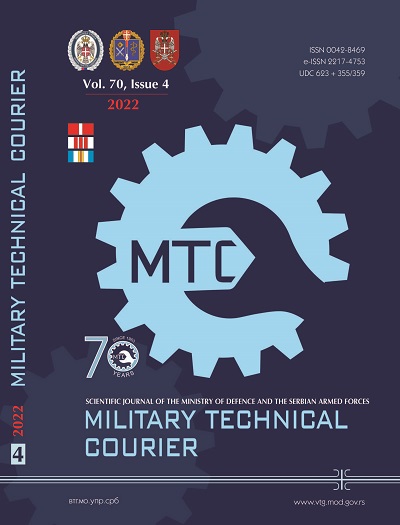Evacuation of aircraft on land
Abstract
Introduction/Purpose: Aircraft present one of the safest and most frequently used means of transport. However, despite taking many security measures, accidents happen. No matter a damage level, if the aircraft somehow manages to land, the most important is to evacuate passengers from the aircraft, fast and safely. Evacuation of aircraft is very complex and depends on many different factors such as a damage degree, presence of fire, speed of passengers, presence of panic and fear, etc. So, it is important to, somehow, as much as possible, predict potential ways of evacuation and potential evacuation strategies and routes. Landed aircraft can be in different conditions so fast and safe evacuation of passengers is very important. The only way to predict safe evacuation routes, to determine proper evacuation strategies and to calculate potential evacuation times needed to leave the aircraft is to use some adequate simulation software.
Methods: In this paper, for calculating needed evacuation times and potential evacuation routes, the simulation method was used. Simulations of evacuation scenarios and calculations of evacuation times were realized in Pathfinder software. The simulation model created in Pathfinder was a model of the A 321 aircraft related to its real dimensions.
Results: The results of this paper, obtained on an appropriate simulation model of the aircraft with stairs and emergency slides, have shown the evacuation times for two different evacuation scenarios with different speeds of passengers/occupants.
Conclusion: A proper evacuation strategy and the fastest evacuation of occupants are crucial for saving lives. Simulation software use in evacuation problems presents a very effective way in terms of safety, cost-effectiveness and prediction. This kind of software presents an obligatory engineering tool for more effective and more precise dealing with evacuation and similar problems. This paper was written to show how simulation software can be used for calculating evacuation times from an airplane on land.
References
-Airbus Aircraft. 2022. A321neo [online] Available at: https://aircraft.airbus.com/en/aircraft/a320/a321neo> [Accessed 14.02.2022].
Choochart, P. & Thipyopas, C. 2020. Study of Passenger Evacuation from the Airbus A330-300 Aircraft. Proceedings, 39(1), art.number:25. Available at: https://doi.org/10.3390/proceedings2019039025>
-CN Traveler. 2022. The 'Miracle on the Hudson' Flight: 8 Things You Might Not Know, a Decade Later [online]. Available at: https://www.cntraveler.com/story/the-miracle-on-the-hudson-flight-things-you-might-not-know> [Accessed 14.02.2022].
Deng., X. 2016. An Aircraft Evacuation Simulation Baseline Using DES for Passenger Path Planning. Master's thesis. Daytona Beach, FL, USA: Embry-Riddle Aeronautical University, College of Aviation [online] Available at: https://commons.erau.edu/edt/207/> [Accessed: 25 February 2022].
Galea, E.R., Owen, M., Lawrence, P.J. & Filippidis, L. 1998. Computer Based Simulation of Aircraft Evacuation and Its Application to Aircraft Safety. In: Proceedings of International Aircraft Fire and Cabin Safety Research Conference, pp.8-15 [online] Available at: https://www.fire.tc.faa.gov/1998Conference/presentations/galraEXODUS.pdf [Accessed: 25 February 2022].
Jevtić, R.B. 2021. Safety in residential buildings - evacuation from residential buildings without fire escape stairs. Vojnotehnički glasnik/Military Technical Courier, 69(1), pp.148-178. Available at: https://doi.org/10.5937/vojtehg67-20742>
Kady, R.A. & Davis, J. 2009. The effect of occupant characteristics on crawling speed in evacuation. Fire Safety Journal, 44(4), pp.451-457. Available at: https://doi.org/10.1016/j.firesaf.2008.09.010>
-Planecrach. 2021. Planecrach info [online] Available at: https://www.planecrashinfo.com/> [Accessed 02.11.2021].
-SKY Bary. 2022. Emergency Evacuation on Land [online] Available at: https://skybrary.aero/articles/emergency-evacuation-land> [Accessed 13.01.2022].
Suharev, A., Shestakov, V. & Vinogradov., L. 2020. Estimation of evacuation time of passengers in aircraft accidents with fire in airfield areas. Aviation, 24(2), pp.72-79. Available at: https://doi.org/10.3846/aviation.2020.12653>
-Thunderhead. 2017. Pathfinder User Manual [online] Available at: https://www2.thunderheadeng.com/files/com/pathfinder/users_guide.pdf [Accessed: 25 February 2022].
Copyright (c) 2022 Radoje B. Jevtić

This work is licensed under a Creative Commons Attribution 4.0 International License.
Proposed Creative Commons Copyright Notices
Proposed Policy for Military Technical Courier (Journals That Offer Open Access)
Authors who publish with this journal agree to the following terms:
Authors retain copyright and grant the journal right of first publication with the work simultaneously licensed under a Creative Commons Attribution License that allows others to share the work with an acknowledgement of the work's authorship and initial publication in this journal.
- Authors are able to enter into separate, additional contractual arrangements for the non-exclusive distribution of the journal's published version of the work (e.g., post it to an institutional repository or publish it in a book), with an acknowledgement of its initial publication in this journal.
- Authors are permitted and encouraged to post their work online (e.g., in institutional repositories or on their website) prior to and during the submission process, as it can lead to productive exchanges, as well as earlier and greater citation of published work (See The Effect of Open Access).

